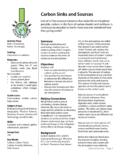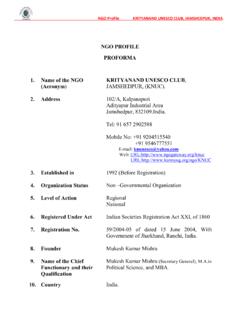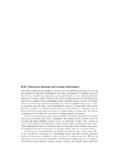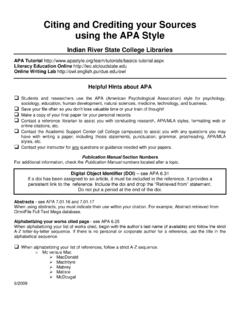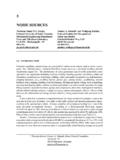Transcription of Carbon Sinks and Sources - tigurl.org
1 Carbon Sinks and SourcesLike all of the essential elements that make life on the planet possible, Carbon , in the form of Carbon dioxide and methane, is continuously recycled on Earth. Have you ever wondered how this cycling works?Activity Time:Part I: 15 minutesPart II: 15 minutesSetting:Classroom or outdoorsMaterials:Class set of Carbon sink and source Who Am I? and Partner cards (see Black Line Masters)Not includedCandle and matchesGreen potted plantFor Demo: red cabbage to be boiled, 2 small glass containers, white vinegar, 1 strawGrade Level: Intermediate, middle school, high schoolSubject Areas: Biology, Ecology, Earth Science, Geography, Physical Science, Resource Science, Science and Technology, Social StudiesSkills: Compare and contrast, gather information, questionGroup Size:10+Key Words: Carbon , Carbon Cycle, Carbon Dioxide, Methane, Sink, Source SummaryThrough questioning and partnering, students gain an understanding of the complex system of Carbon cycling that works to balance the levels of Carbon in our will.
2 Gain an understanding of how Carbon cycling occursUse questioning techniques to determine the differences between a Carbon sink and a Carbon sourceDiscuss how humans can influ-ence the amount of Carbon in our atmosphereMaking ConnectionsWe all have a role to play in combating climate change. However, the issue can seem so huge and the solutions so daunting that individual actions seem insignificant. It is important for students to understand that simple choices made every day can have profound impact in the mitigation of the effects of climate Carbon dioxide (CO2) and it s sister greenhouse gas, Methane (CH4), are continually recycled on Earth. Processes that release CO2 to the atmosphere are called Carbon Sources , while processes that absorb it are called Carbon Sinks . Forests, soil, oceans, the atmosphere, and fossil fuels are important stores of Carbon . Carbon is constantly moving between these different stores, that act as either Sinks or Sources .
3 A sink absorbs more Carbon than it gives off, while a source emits more than it absorbs. The amount of Carbon in the atmosphere at any one time depends on the balance that exists between the Sinks and Sources . This system of Sinks and Sources operates all over the planet and is known as the Carbon Sources of atmospheric CO2 include volcanoes, fires, decomposition, respiration, digestion and, under certain conditions, oceans and fresh water bodies. The latter can release large amounts of dissolved CO2 when waters warm up or are disturbed by storms or tremors. Natural Sinks for atmospheric CO2 include photosynthesis, forests, oceans and freshwater bodies, fossil fuels and carbonate rocks. Before the Industrial Revolution, the amount of Carbon moving between trees, soil, oceans and the atmosphere was relatively Sinks & Sources Page Sinks & Sources Page Carbon Sinks and Sourcesbalanced.
4 The forests of the world are a big Carbon sink however deforestation is reducing the size of this sink, allowing more Carbon dioxide to remain in the atmosphere. Photosynthesis accounts for about half of the Carbon extracted from the atmosphere. Photosynthesis equation: 6 H2O (water) + 6 CO2 + sunlight energy = C6H12 O6 (glucose) + 6 O2 (oxygen). Land plants take most of their Carbon dioxide from the air around them while aquatic plants in lakes, seas and oceans uses Carbon dioxide dissolved in water. Phytoplankton is one of these important plants as they produce up to 50% of the atmospheric oxygen through photosynthesis. Other important Sinks are the worlds oceans. The world s oceans are absorbing an unprecedented amount of Carbon dioxide (CO2), which is increasing their acidity and possibly threatening the long-term survival of many marine species, especially calcifying organisms including corals, shellfish and phytoplankton (UNESCO, 2004).
5 See demo activity in Warm Up section to illustrate this cycling of Carbon between the atmosphere, plants and animals can take place quickly, over the space of days or weeks. Individual Carbon atoms may cycle through plants and animals several times a year. Other parts of the cycle, especially those involving the storage of Carbon as an underground mineral, may take millions of years to perturbations to the Carbon cycle are impacting the maintenance of the concentration of atmospheric Carbon . This is leading to an increase in the amount of Carbon in the atmosphere as humans produce Carbon dioxide and methane far faster than the natural Sinks can absorb it. The extraction, processing and use of oil, gas and coal are the greatest contributors to this Carbon loading. Sources of methane (CH4) include natural Sources like wetlands, gas hydrates in the ocean floor, permafrost, termites, oceans, freshwater bodies, and non-wetland soils.
6 Fossil fuels, cattle, landfills and rice paddies are the main human-related Sources . All these Sources cause significant Carbon emissions. Methane (CH4) is an important trace gas in Earth s atmosphere. Even though it only makes up ( parts per million by volume) of the atmosphere, methane (CH4) traps a significant amount of heat, helping the planet remain warm and habitable. The amount of methane (CH4) in the atmosphere is the result of a balance between production on the surface and destruction in the atmosphere. Methane (CH4) forms when organic matter decomposes in oxygen-poor environments, such as marshes, rice paddies, or the digestive systems of cattle. It also comes from combustion (burning) of Carbon -based fuels. Each methane (CH4) molecule holds about 23 times more heat than 1 molecule of Carbon dioxide. Methane (CH4) is 23 times more potent than Carbon dioxide as a greenhouse gas, but CO2 is much more abundant than methane and the predicted growth rate is far addition to contributing significantly to Carbon Sources , human activities are also interfering with natural Carbon Sinks .
7 For example, the clearing of tropical rainforests for agriculture and logging represents a significant loss to the earth s ability to absorb and store UpLight the candle and ask students what they observe candle, wick, flame. What is burning here the wick or the wax or both? Where do they go when they are burned? Do they just disappear forever? Blow out the & Sources Page Carbon Sinks and SourcesDemo ActivityThis experiment shows the acidifying effect of CO2 . Make an organic, non-toxic pH indicator by boiling red cabbage in a covered pan for 30 minutes or mi-crowave for 10 minutes. (Do not let the water boil away.)Let cool before removing the about 1/4 cup of cabbage juice into 2 see through containers. (Avoid buying plastic for this Plastic is a petro-leum product. Its production process is a source of Carbon emission and it doesn t decompose.)Slowly pour white vinegar in one of the containers.
8 Ob-serve the change in , ask a student to blow through a straw in the other container. Eventually the cabbage juice will turn student what he or she is breathing out into the cabbage What is the meaning of the juice changing colour? dissolved in water, CO2 com-bines with water to form carbonic acid H2CO3. This is a weak unstable acid. However, if concentrated enough this acid will over time dis-solve the calcium shell of marine organisms. Driving too much could literally kill the Great Barrier ActivityPart I . Draw a quick illustration of the Carbon cycle on the board. Give a brief definition of Sinks and Sources . Processes that release CO2 to the atmosphere are called Carbon that absorb CO2 are called Carbon Sinks .. Ask students for examples of processes that release CO2 to the atmosphere - Carbon Sources . List the Sources on the boardPoint to the candle Us - we breathe out CO2 we are Carbon Sources along with all air-breathing organ-ismsVolcanoesFiresOceans and fresh water bodies (CO2 dissolves easily in water) Agriculture - grazing animals Sinks & Sources Page Carbon Sinks and Sources (cows, sheep, pigs) produce methaneBurning fossil fuels gas energy plants, coal, oil, gas, tar sandsFossil fuel production: coals, oil gas, tar sands including the burning of natural gas during oil extraction (water, oil and gas mix) and the escape of methane (CH4) during extrac-tion and processing of oil, gas and garbage in landfills/ dumps (methane)Rice farms (produce methane)Degrading farm soils.
9 Release of Carbon from soils when plowed - causes it to oxidize creating CO2 Wetland destructionDeforestationUrban sprawlDecomposition of dead animal and plants with oxygen (aero-bic) produces CO2 Decomposition of dead ani-mal or plants without oxygen (anaerobic) produces methane (CH4) . Ask students for examples of processes that absorb Carbon dioxide from the atmosphere - Carbon Sinks . List the Sinks on the boardPoint to a green plant - photo-synthesis in plants. All green plants, peat bogs (these are green plants in storage), grow-ing forests: photosynthesis equation 6 H2O (water) + 6 CO2 + sunlight energy = C6H12 O6 (glucose) + 6 O2 (oxygen) glucose = Carbon , algaeFossilized organic remains be-come fossil fuels like coal, oil and gas stored safely undergroundOceans can absorb CO2 di-rectly from the atmosphere. CO2 will stay in storage for a long time provided oceans stay cool and undisturbed.
10 The Carbon hydrate is in the slurry at the bottom in the form of sedimentsShells, coralCarbonate rocksPermafrostWetlands organic matter builds up at bottom of ponds providing long-term storage of carbonSoilLimestone / dolomite sedi-mentary rocks: shale, mud-stone, and coal. The Rocky Mountains are a good exam-ple of this.. Reiterate that this system of Sinks and Sources operates all over the globe and is known as the Carbon Cycle. 5. Explain to students that they are about to become either a Carbon sink or a Carbon source. They will not know which they are but will have to figure it out by asking questions that can be an-swered only by yes or no. Note: it may be necessary to demonstrate what yes/no questions sound Hang a card on each student s back so the wearer cannot see it. Participants must circulate and ask others just one Yes or No question to determine what they are.
